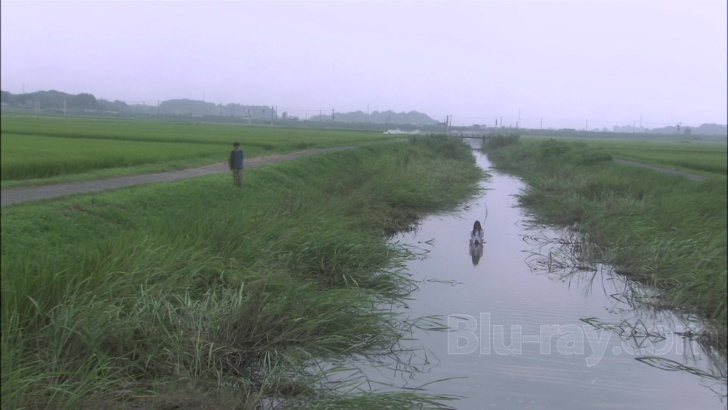

Composer Toru Takemitsu, who had contributed to the soundtrack of the Nikkatsu “Sun Tribe” film Crazed Fruit(1956), turns in a jazzy score as perfectly in sync with the contemporary events of the film as his later dissonant works were with Shinoda’s more existential explorations he eventually scored 16 Shinoda films in all. Terayama would go on to write four more of Shinoda’s films, most of them among his best works.

Avant-garde poet, playwright, and future filmmaker Shuji Terayama contributes a cynical and complex screenplay which not only casts a skeptical eye on the political scene in general, with its lead character alienated from both the left and the right, but also incorporates contemporary events like the then-current, massive protests against the renewal of the Japanese-American Joint Security Treaty.

Dry Lake is especially significant in that it marks Shinoda’s first collaboration with three other artists who would become regular partners throughout his career. Among them, an opportunistic poor kid (who worships dictators and has posters of Hitler, Roosevelt, and Mussolini on his bedroom walls) pinballs between a conservative politician and left-wing demonstrators, all leading to a violent finale. Again mirroring the Nikkatsu style, Dry Lake echoes that studio’s then-popular “Sun Tribe” movies by depicting the lives of bored rich kids and their dissatisfaction with mainstream Japanese society. Nevertheless, as a debut film its naiveté is evident, a deficiency Shinoda quickly addressed in his follow-up feature.ĭry Lake (1960), available on FilmStruck under its alternate title Youth in Fury, could be considered Shinoda’s true debut, in that it’s a much more mature film, addressing issues that would come up as regular themes in his later works. Shinoda’s original script turns a critical eye on the poisonous aspects of the then-nascent talent-management culture, like its intrusions into performers’ personal lives, and it often feels like a pop-romance film from neighboring studio Nikkatsu, but with the addition of more adult themes and social realism. The result, One-Way Ticket to Love (1960), was a clichéd but entertaining black-and-white youth melodrama, set in the showbiz world, about a down-on-his-luck saxophone player who gets involved with a young woman he saves from a suicide attempt one rainy night, only to watch her fall in with a handsome pop singer. Shinoda began his career at Shochiku Studios in 1953 as an assistant director, and in 1960 he was allowed to write and direct his first feature, made very much in the studio house style and built around the Japanese cover version of a popular 1959 Neil Sedaka song. Thankfully, and due to the rise in popularity of video streaming services such as FilmStruck, the Criterion-TCM partnership, more than half of the director’s exceptionally diverse filmography is available to watch at home via streaming only, including Double Suicide and the director’s other two films previously available on home video: the brilliant and brooding gangster noir Pale Flower (1964) and Shinoda’s last film as a studio contract director, the bizarre, convoluted ninja saga Samurai Spy (1965). But Shinoda is known abroad primarily for one film, Double Suicide (1969), his highly theatrical adaptation of a Chikamatsu play, performed and shot in the style of bunraku puppet theater. Like Masumura, Masahiro Shinoda is another filmmaker well-known in his home country as one of the primary figures of the Japanese New Wave movement of the 1960s. For every Akira Kurosawa, whose entire feature filmography has been made available to English-speaking viewers on home video, there’s a Yasuzo Masumura, whose works available in translation are limited, for a variety of reasons, and represent only a tiny portion of his entire creative output. But the number of titles available with English subtitles, while large, still pales when compared to the depth and breadth of Japanese film history. home video is sometimes astounding, if you take into consideration what was released on VHS, then laserdisc, DVD, and finally Blu-ray. The wealth of older Japanese films available on U.S.

Note: you must be logged in to FilmStruck for the links to work.


 0 kommentar(er)
0 kommentar(er)
